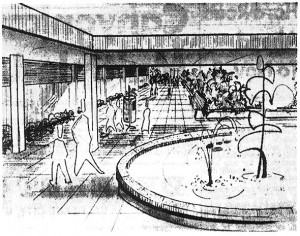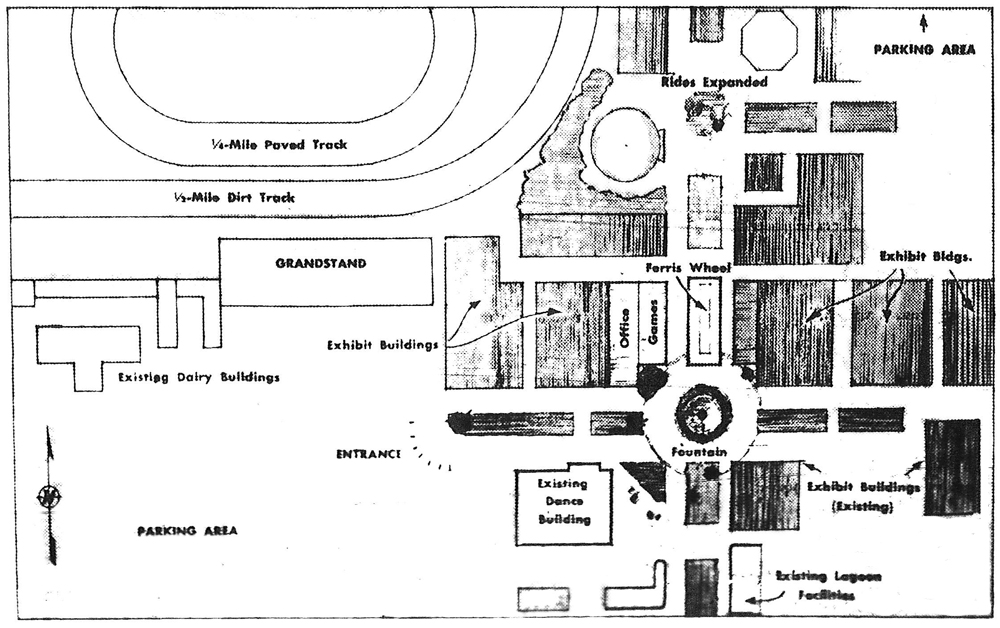By the mid-1960s, the Davis County Fair had not been held in its original location at Lagoon for roughly 20 years. The much larger Utah State Fair, with a history dating back to 1856, had been utilizing the same buildings for about 60 years. In August 1964, Lagoon manager Robert Freed sent a proposal to the president of the Utah State Fair Board suggesting the state fair move to Lagoon. As reported by the Deseret News, Freed’s proposal outlined the following benefits of having the state fair at Lagoon:
1. It would become truly a ‘State Fair’ by locating on a multi-lane interstate highway, midway between Utah’s two largest cities and population centers.
2. Lagoon’s facilities, promotional program and ‘wholesome image’ would enhance the fair and increase its attendance.
3. The amusement park’s midway with its ‘reasonable operation and control’ would remove any transient carnival atmosphere from the fair. Lagoon’s lower-than-usual midway prices would not be increased during the fair.
4. The fair board and manager could concentrate on the fair itself and dispense with the problem of building maintenance during the 355 days of the year when the fair is not held.
5. The fair can be self-supporting without capital investment by the state for remodeling or contracting concessionaires.
6. Fair facilities will no longer compete with private enterprise during the non-operating part of the year.
7. Problems of parking, congestion and antiquated buildings will be eliminated by moving to Lagoon.
8. New Lagoon buildings would provide the fair with a ‘new look.’
9. Other state fairs have ‘flourished’ under a similar arrangement – the Texas State Fair, for example, held at a Dallas permanent amusement park.
10. The state can dispose of present fair property at a profit or use it for other purposes.
11. Complaints of noise and congestion by neighbors of present fair property would be eliminated by moving from a residential location.
In a way, having the state fair at Lagoon would also extend the operating season at a time when the park usually closed down after Labor Day. The tentative plans included extensive changes to the north end of the park. The Ferris Wheel which stood at the end of the Midway would have been moved further north to allow the installation of a fountain and a new entryway on the other side of the Patio Gardens dance pavilion. More rides would have been added even further north with new picnic pavilions doubling as exhibition buildings during the fair. The new buildings would have been inter-connected in “a contemporary architectural style” – much like an outdoor shopping mall (as shown in the illustration above). A new grandstand was also to be built with a ½-mile race track modified from the existing, defunct track.
The process of finalizing plans wouldn’t have been a simple process. After being agreed upon by the Utah State Fair Board, the 1965 Utah Legislature would have had to change the state constitution which required the fair to be in the capitol city. Then it would need to be included on the November 1966 election ballot for voters to consider.
Even though the president of the Fair Board said there was a possibility of the plan being accepted, no further reports on the plan’s rejection¹ seem to have been printed in papers. Instead, just a matter of weeks later, Davis County Fair officials were reportedly giving serious consideration to moving the county fair back to Lagoon. They had recently sold the fairgrounds near Davis High School in Kaysville to the school district and were looking for a new venue for the fair. In the spring of 1965, an agreement was made between the Davis County Fair and Lagoon, but some of the plans announced for the Utah State Fair were still going forward on a smaller scale. A new expansion on the north end of the Midway that year featured a new fountain as planned for the state fair. Other additions originally planned for the state fair such as the Davis Pavilion and Davis Stadium were completed soon after. Opera House Square was added in 1968 on the east end of what would have been the new entrance and the further expansion to the north never took place until 1986 after the county fair relocated once again and new rides were installed on the former grounds.
There are other connections between Lagoon and the Utah State Fair, but more information is still needed. I have come across some references that suggest Lagoon may have operated rides at the state fair for an unknown period of time. Also, a former employee once told me Lagoon’s Sky Slide was sold to the state fair in the ’70s or ’80s.

NOTES
1. It’s likely plans for the state fair at Lagoon were simply abandoned once it was apparent that the Davis County Fair had a greater need for the space at Lagoon. Over the years, consideration has been given to moving the state fair to other places like the Salt Palace and the Weber County Fairgrounds in Ogden, but the Utah State Fair continues to be held at the Fairpark in Salt Lake City. The original buildings have since been remodeled or torn down.

more from lhp

SOURCES
Why Not Move Fair To Lagoon?. Deseret News, 13 Aug 1964.
State Fair At Lagoon? Board Ponders the Move. Davis County Clipper, 21 Aug 1964.
Lagoon Sets 69th Season. Deseret News, 26 May 1965.
3 are still recovering from Friday slide rides. Deseret News, 14 Sep 1983.
Lagoon Summer Shows. Deseret News, 23 Jul 1993.
Palmer, Douglas D. Fair board to study Weber offer. Deseret News, 3 Aug 1994.
Whirlwind Update and More. Email message to author, 20 Oct 2005.
History of the Fair. UtahStateFair.com, accessed 12 Sep 2012.






